Adding it up: How partnerships between industry, academia and technology are accelerating additive innovations
Last month the GE Additive Education Program launched its 2018 cycle. Now in its second year, the program aims to give students around the world and in all grades exposure to additive manufacturing and promote interest in science, technology, engineering and math.
GE is investing $10 million over five years in educational programs to provide polymer-based 3D printers to primary and secondary schools and metal printers to universities around the world.
We know the combined power of industry, academia and technology to accelerate innovation and technology shifts. It’s a model that is often discussed, but one that often remains unachievable or aspirational for a number of reasons.
So, when things do fall into place, I often call this a perfect trifecta. And more often than not it is the vision and aspirations of a number of individuals who drive these smaller ecosystems that can drive big shifts.
One great example is Proto Precision Manufacturing Solutions based in Hilliard, Ohio. After more than twenty years in the traditional manufacturing business, Proto Precision was ready to introduce metal additive manufacturing and turned to the Center for Design and Manufacturing Excellence (CDME) at The Ohio State University to drive the metal printing forces. CDME presents a unique cross section of technology, industry and research and is a valuable extension of Ohio State’s College of Engineering. Bringing together an innovative small business like Proto Precision with GE Additive and Ohio State’s staff and faculty is an essential part of CDME’s portfolio, as this addresses some of the biggest challenges in manufacturing.

We often see industry turning to universities for local support and workforce development. But it’s also critical that they partner with a technology solutions provider, one that can grow with them as the ecosystem develops. Proto Precision selected GE Additive to be its source of additive equipment and the three organizations formed the trifecta model.
A memorandum of understanding with Ohio State will see Proto Precision install two recently purchased GE Additive machines on OSU’s Columbus campus this month. A third and fourth GE Additive machine will remain on site at Proto Precision’s facility in Hilliard, and the company plans to hire an additional four to six engineers in coming months. The partnership of GE Additive and Ohio State’s CDME accelerates the growth of the additive ecosystem in Central Ohio and empowers Proto Precision to meet the needs of a growing customer base.
Ohio State’s particular expertise in medical technology research and development was a key factor for the Proto Precision team. Once installed, engineering students, staff and faculty will have access to the machines to advance their research, and Proto Precision will fulfill their production work for them. The partnership with Proto Precision and GE Additive is an opportunity for Ohio State researchers to apply cutting-edge innovation in the medical additive space.
Moving forward, the team hopes to benefit from having the world’s largest powder bed machine to print large, highly complex parts, apply the learnings from this collaborative approach and build on the university’s existing industry partnerships within the aerospace and automotive sectors, such as Honda of America and GE Aviation.
By leveraging the other GE business units, in particular our colleagues at GE Capital, we’ve been able to help Proto Precision transform by providing the ability to pick and mix from a portfolio of scalable technology solutions and provide customized financing arrangements that are suited to its business needs today and tomorrow.
As traditional manufacturers begin to transform and harness the potential of additive manufacturing, we are observing an emerging need for industry, universities and technology providers to build stronger ecosystems together. We were a part of that with Orange Coast College. Last year, we also helped launch the largest academic-based additive hub in the Southwest at Arizona State University with Honeywell Aerospace and PADT, Inc.
In terms of driving innovation forward, knowledge sharing and collaboration, such models can yield great results. However, achieving a perfect trifecta of collaboration requires engagement, commitment and a vision from the outset if they are to come to fruition – you cannot simply wait for the stars to align.
Get in touch if you are thinking about building your own additive manufacturing ecosystem – we’d be happy to share our experiences.
